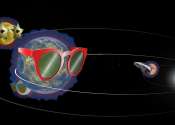NASA engineer develops tiny, high-powered laser to find water on the moon
Finding water on the moon could be easier with a Goddard technology that uses an effect called quantum tunneling to generate a high-powered terahertz laser, filling a gap in existing laser technology.









